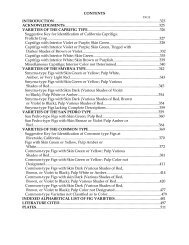Fig Produce Facts - Figs 4 Fun
Fig Produce Facts - Figs 4 Fun
Fig Produce Facts - Figs 4 Fun
You also want an ePaper? Increase the reach of your titles
YUMPU automatically turns print PDFs into web optimized ePapers that Google loves.
<strong>Fig</strong> <strong>Produce</strong> <strong>Facts</strong><br />
<strong>Fig</strong><br />
Recommendations for Maintaining Postharvest Quality<br />
Carlos H. Crisosto, Elizabeth J. Mitcham and Adel A. Kader<br />
Department of Plant Sciences, University of California, Davis, CA 95616<br />
Maturity Indices<br />
Fresh market figs must be harvested when almost fully ripe to be of good eating<br />
quality. Skin color and flesh firmness are dependable maturity and ripeness<br />
indices ‘Black Mission’ figs should be light to dark purple rather than black and<br />
should yield to slight pressure. ‘Calimyrna’ figs should be yellowish-white to light<br />
yellow and firm.<br />
Quality Indices<br />
Fresh figs’ skin color and flesh firmness are related to their quality and<br />
postharvest-life. Flavor is influenced by stage of ripeness and overripe figs can<br />
become undesirable due to fermentative products. Other quality indices include<br />
absence of defects (such as bird-peck, sunburn, scab, skin break, and stem<br />
shrivel), insects, and decay.<br />
Optimum Temperature<br />
-1°C to 0°C (30°F to 32°F)<br />
Expedited forced-air cooling to 0°C (32°F) is strongly recommended.<br />
http://web.archive.org/web/20070813223825/posthar....ucdavis.edu/<strong>Produce</strong>/<strong>Produce</strong><strong>Facts</strong>/Fruit/fig.shtml (1 of 4) [6/10/2009 10:30:58 PM]
<strong>Fig</strong> <strong>Produce</strong> <strong>Facts</strong><br />
Optimum Relative Humidity<br />
90-95%<br />
Rates of Respiration Production<br />
Temperature ml CO 2 / kg·hr<br />
°C °F<br />
0 32 2-4<br />
5 41 5-8<br />
10 50 9-12<br />
20 68 20-30<br />
§ To calculate heat production, multiply ml CO 2 /kg·hr by 440 to get BTU/ton/day<br />
or by 122 to get kcal/metric ton /day.<br />
Rates of Ethylene Production<br />
Temperature 0°C(32°F) 5°C(41°F) 10°C(50°F) 20°C(68°F)<br />
ul C 2 H 4 /kg·hr 0.4-0.8 0.8-1.5 1.5-3.0 4.0-6.0<br />
Responses to Ethylene<br />
<strong>Fig</strong>s are slightly sensitive to ethylene action on stimulating softening and decay<br />
severity, especially if kept at 5°C (41°F) or higher temperatures.<br />
Responses to Controlled Atmospheres (CA)<br />
CA combinations of 5-10% oxygen and 15-20% carbon dioxide are effective in<br />
decay control, firmness retention, and reduction of respiration and ethylene<br />
production rates. Postharvest-life at optimum temperature and relative humidity<br />
depends upon cultivar and ripeness stage at harvest and ranges from 1 to 2<br />
weeks in air and from 3 to 4 weeks in CA for California-grown ‘Black Mission’ and<br />
http://web.archive.org/web/20070813223825/posthar....ucdavis.edu/<strong>Produce</strong>/<strong>Produce</strong><strong>Facts</strong>/Fruit/fig.shtml (2 of 4) [6/10/2009 10:30:58 PM]
<strong>Fig</strong> <strong>Produce</strong> <strong>Facts</strong><br />
‘Calimyrna" figs.<br />
Physiological & Physical Disorders<br />
CA-related disorders. Extended storage in CA can result in loss of characteristic<br />
flavor. <strong>Fig</strong>s exposed to less than 2% oxygen and/or more than 25% carbon<br />
dioxide develop off-flavors due to fermentative metabolism.<br />
Pathological Disorders<br />
Alternaria rot. Caused by Alternaria tenuis, appears as small, round, brown- toblack<br />
spots over the fruit surface. Any cracks on the skin make the fruit more<br />
susceptible to the rot.<br />
Black mold rot. Caused by Aspergillus niger, appears as dark or yellowish spots<br />
in the flesh with no external symptoms. At advanced stages the skin and flesh<br />
turn slightly pink color and white mycelia with black spore masses follow.<br />
Endosepsis (soft rot). Caused by Fusarium moniliforms, appears in the cavity of<br />
the fig making the pulp soft, watery and brown with sometimes an offensive<br />
odor.<br />
Souring. Caused by various yeasts and bacteria, is a preharvest problem<br />
resulting from yeasts and bacteria carried into the figs by insects, especially<br />
vinegar flies, resulting in smells of alcohol or acetic acid.<br />
Control of Postharvest Diseases.<br />
●<br />
●<br />
●<br />
●<br />
●<br />
Control of orchard insects to reduce fruit damage and transmission of<br />
fungi.<br />
Effective control of preharvest diseases.<br />
Strict sanitation of picking and transporting containers.<br />
Careful handling to minimize abrasions, cracks, and other physical<br />
damage.<br />
Do not pick figs for fresh market from the ground.<br />
Prompt cooling to 0°C (32°F) and maintaining the cold chain all the way to<br />
the consumer.<br />
Search PTRIC<br />
(enter search words)<br />
http://web.archive.org/web/20070813223825/posthar....ucdavis.edu/<strong>Produce</strong>/<strong>Produce</strong><strong>Facts</strong>/Fruit/fig.shtml (3 of 4) [6/10/2009 10:30:58 PM]
<strong>Fig</strong> <strong>Produce</strong> <strong>Facts</strong><br />
Postharvest Technology Research Information Center<br />
Department of Plant Sciences<br />
Mail Stop 2, Room 3047 Wickson Hall<br />
University of California<br />
One Shields Ave., Davis, CA 95616-8683<br />
Send comments to postharvest@ucdavis.edu<br />
Site Map<br />
Copyright ©1996-2007.<br />
Legal notices. All rights reserved.<br />
<strong>Produce</strong>/<strong>Produce</strong><strong>Facts</strong>/Fruits/fig.shtml updated November 12, 2006<br />
http://web.archive.org/web/20070813223825/posthar....ucdavis.edu/<strong>Produce</strong>/<strong>Produce</strong><strong>Facts</strong>/Fruit/fig.shtml (4 of 4) [6/10/2009 10:30:58 PM]















![Fig Trees in North Carolina [Archive] - IDigMyGarden ... - Figs 4 Fun](https://img.yumpu.com/26905320/1/190x245/fig-trees-in-north-carolina-archive-idigmygarden-figs-4-fun.jpg?quality=85)

